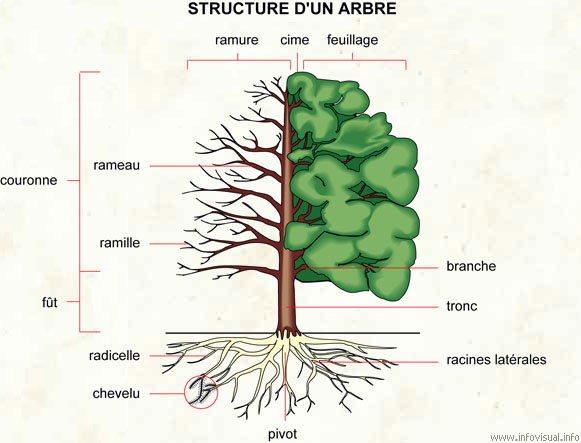Arbre

Ramure: branches et rameaux d'un arbre.
Cime: partie la plus haute de l'arbre.
Feuillage: ensemble des feuilles.
Branche: forte ramification du tronc d'un arbre.
Tronc: corps de l'arbre.
Racines latérales: ramifications situées sur le côté et sous terre, servant à maintenir l'arbre en place et à le nourrir.
Pivot: racine principale enfoncée verticalement dans le sol.
Chevelu: partie de la racine qui est remplie de filaments.
Radicelle: petite racine.
Fût: partie de l'arbre entre les premières branches et le sol.
Ramille: division des rameaux.
Couronne: partie de l'arbre de la première branche à la cime.
Rameau: division des branches.
Photo :

A tree is a perennial woody plant. It is most often defined as a woody plant that has secondary branches supported clear of the ground on a single main stem or trunk with clear apical dominance. A minimum height specification at maturity is cited by some authors, varying from 3 m to 6 m; some authors set a minimum of 10 cm trunk diameter (30 cm girth). Woody plants that do not meet these definitions by having multiple stems and/or small size, are called shrubs. Compared with most other plants, trees are long-lived, some of them getting to be several thousand years old and growing to up to 115 m (375 ft) high.
Trees are an important component of the natural landscape because of their prevention of erosion and the provision of a specific weather-sheltered ecosystem in and under their foliage. Trees have also been found to play an important role in producing oxygen and reducing carbon dioxide in the atmosphere, as well as moderating ground temperatures. They are also significant elements in landscaping and agriculture, both for their aesthetic appeal and their orchard crops, such as apples. Wood from trees is a common building material.
A tree is a plant form that occurs in many different orders and families of plants. Trees show a wide variety of growth forms, leaf shapes, bark characteristics, and reproductive organs. The tree form has evolved separately in unrelated classes of plants, in response to similar environmental challenges, making it a classic example of parallel evolution. With an estimate of 100,000 tree species, the number of tree species worldwide might total 25 percent of all living plant species.
Animation : L'arbre en accéléré
Merci à YouTube de nous permettre d'observer ce vidéo.
Objet virtuel : L'arbre en accéléré
Merci à YouTube de nous permettre d'observer ce vidéo.